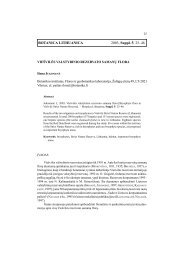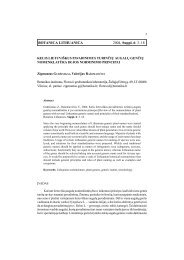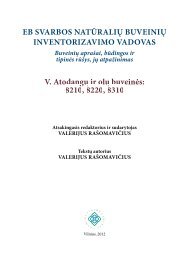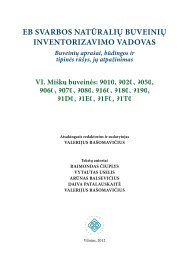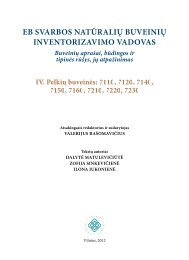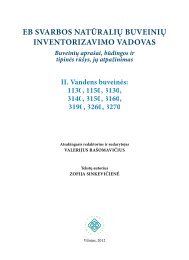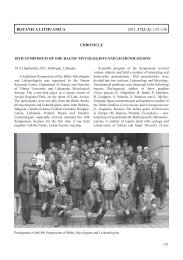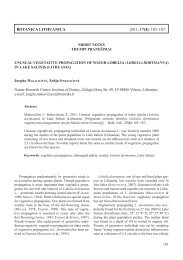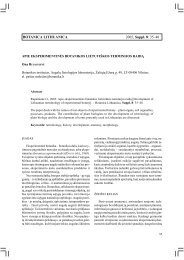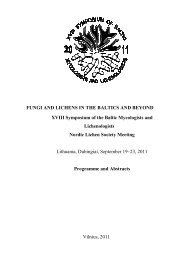Botanica Lithuanica 2011, 17(2–3): 117–125
Botanica Lithuanica 2011, 17(2–3): 117–125
Botanica Lithuanica 2011, 17(2–3): 117–125
Create successful ePaper yourself
Turn your PDF publications into a flip-book with our unique Google optimized e-Paper software.
MATERIALS AND METHODSThe study of vascular plant flora in the abandonedsand and gravel quarry of Beržupis has been carried outsince 2005. In this paper, the data collected in the periodof 2005–2008 are presented. Beržupis quarry is locatedin the area of the continental dunes of the LithuanianSoutheastern Sandy Plain (Basalykas, 1958). Beržupisgravel-sand pit, where the above-mentioned quarry occurs,is located 2 kilometres in the northeast directionof Varėna town, on the right bank of Derėžnyčia stream.The geographical coordinates of the centre of the quarryare N 54º 13' 55" E 24º 36' 00". The area of the quarryis about 3.5 hectares. Its exploitation was launched in1960; the mine was closed in 1977. After the closure,a part of the territory was planted with Pinus sylvestrisand Betula pendula, another part was left for naturalovergrowing.At the beginning of the research, general botanical,bryological and ecological data on the quarry ofBeržupis were collected applying route method. Duringa special floristic examination, the territory of Beržupisquarry was divided into two main structural parts:the slopes and the bottom. The composition and frequencyof vascular plant and moss species in Beržupisquarry was estimated following the route-spot method(Korčagin, 1964). Based on the orientation, the slopesof the quarry were divided into southern, eastern, westernand northern parts. Route directions within theboundaries of each slope were twofold: (1) from the topof the slope downwards the bottom of the quarry and(2) from the bottom of the slope up to the top. The areaof the record was visually determined to be 1 squaremetre. Distance between the record points in one routewas 10 metres, distances between routes – 20 metres.Following the same method, frequency of vascularplant species was estimated in the natural forest and atthe bottom of the quarry. However, due to its considerableheterogeneity and pursuing to evaluate frequency ofthe studied plants more precisely, the distance betweenthe record points was five metres, distances betweenroutes – 10 metres.On the slopes of Beržupis quarry, the frequency ofvascular plant species was rated by 311 points, including:on the southern slope – 73, eastern – 101, northern– 77, western – 60, whereas at the bottom of thequarry – by 1097 points. Thus, in all quarry the frequencyof vascular plants species was rated by 1408 points.The same method was used for the examination ofnatural pine forest, located next to the quarry. The forestbelongs to the Querco roboris-Pinetum sylvestrisW. Matuszkiewicz 1988 association (Navasaitis et al.,2003). Pinus sylvestris trees in this forest are about 60years old. The frequency of vascular plant species wasevaluated by 483 points.RESULTS AND DISCUSSIONThe study of the territory of Beržupis quarry revealedthe process of anthropogenic system’s changeinto a natural system, which is specific, atypical for thepine forest in the southern Lithuania and has formedin almost 30 years after the end of sand and gravel extraction.We suppose that changes in the flora of thisanthropogenic system have been mostly influenced bythe former pioneering of substratum and ecological heterogeneityof the present habitats. It might be the mainreason for the establishment in the territory of the formerquarry of atypical vascular plant species, in manycases totally unusual to the communities of pine forests.Applying route and route-spot methods, 198 taxa wereidentified in the territory of Beržupis quarry: six hybrids,three varieties and two forms. Of these, 14 alienplant species were recorded. In the examined territoryof Beržupis quarry, five plant species enlisted in theLithuanian Red Data Book were found. Twenty eightvascular plant species were identified in the natural forestused as a control. Among them no alien species orspecies of the Lithuanian Red Data Book were found.Thus, in the natural forest, Pinus sylvestris (frequency42 %) and Juniperus communis (27 %) dominatedamong trees and bushes; Calluna vulgaris, Chimaphilaumbellata and Vccinium vitis-idaea (frequency of each10 %) prevailed among dwarf shrubs, Deschampsiaflexuosa (19 %) dominated among herbaceous plants.Only a few of these species grew in the territory of thequarry: Vaccinium vitis-idaea, Chimaphila umbellata,Deschampsia flexuosa, Juniperus communis and Pinussylvestris, their frequency in the quarry was 0.2, 4, 6,13 and 34 %, respectively. Proper evaluation of naturallyestablished Pinus sylvestris was impossible due toformer afforestation of the partial territory of the quarrywith this tree species. Plant species dominant in the naturalforest, according to their requirements of the soilhumidity, take the intermediate position between dryand moderate humidity soils (Ellenberg, 1974). Considerabledifferences not only in the flora compositionof the slopes and the bottom of the quarry, but also inthe species frequency were revealed.118
from the ecological point of view, the bottom of thequarry is a particularly heterogeneous area. The reasonof this ecological heterogeneity is the three types of specifichabitats formed due to difference in relief forms: 1)dry elevation with Pinus sylvestris, Pleurozium schreberiand Hylocomnium splendens; 2) humid depressionswith Phragmites australis and the species of Salixgenus; 3) open flooded areas with Elodea canadensisand Potamogeton natans. Specific hydrological conditionsat the bottom of the quarry allow the growth ofvascular plant species from different ecological groups,for example, Phleum pratense and Anthoxanthum odoratum,which are characteristic of meadows, and Droserarotundifolia and Trichophorum alpinum, typical ofraised bogs. Due to prolonged flooding of deeper placesof the quarry bottom, a number of Carex species werefound, and in some places big areas were occupied withPhragmites australis. Sphagnum palustre, S. magellanicum,S. squarrosum and S. girgensohnii activelyparticipated in paludification processes, which startedin some places of the quarry’s bottom. Distribution ofplant species in various places was very uneven becauseof differences in hydrological conditions characteristicof the bottom of the quarry. For example, higher, drierplaces of the bottom were dominated by Calamagrostisepigejos (frequency 60 %), while on all the surface ofthe quarry’s bottom its frequency decreased to 27 %.Further example: humid depressions were conside-Frequency, %Fig. 2. Frequency of vascular plant species dominant on the south-facing slope of Beržupis quarry (frequencyabove 10 %)Fig. 3. Frequency of vascular plant species on different slopes of Beržupis quarry (frequency above 10 %)120
ably dominated by Salix pentandra (100 %), S. nigricans(60 %), S. aurita (49 %) and Phragmites australis(41 %), whereas in all area of the quarry’s bottom, thefrequency of these species made up 39, 42, 38 and 27%, respectively.In general, participation of Salix species in the floracomplex at the bottom of the quarry can be explainedby the fact that the seeds of Salix genus of the temperateclimate zone do not have a rest period and sproutjust after maturity (Smaliukas, 1996). Furthermore, almostpermanent water on the surface in this part of thequarry’s bottom creates hydrological conditions, whichare also favourable to the plants of Salix genus. Anotherreason of the dominance of Salix on the quarry’s bottomis the ability to form root shoots in the bark while growingin standing water.Vascular plants dominant on the quarry’s bottom(Pyrola rotundifolia, Equisetum variegatum, Salixpentandra, etc.) are generally restricted (Ellenberg,1974) to moderately humid and humid soils. An importantrole is also played by Phragmites australis, whichis characteristic of sodden soils, and by the plants thatare indifferent to humidity (Salix purpurea, Calamagrostisepigejos).Some typical species of south-facing slope (Astragalusarenarius, Artemisia campestris) were also foundat the bottom of the quarry, but their frequency was verylow. For example, Solidago virgaurea was sufficientlyabundant on all slopes of the quarry, but its frequencyat the bottom, in comparison with the slopes, decreasedfrom 19 to 4 %.One of the species common to the bottom and theslopes of the quarry was Equisetum variegatum (Fig. 5).Frequency of this evergreen species at the bottom ofthe quarry reached 45 %, whereas on the slopes – 9 %.Abundance of E. variegatum partial tufts in many placesof the quarry’s bottom formed solid thickets. Evenon the dry sandy south-facing slope, the frequency ofE. variegatum was 19 %. Actually, E. variegatum didnot form thickets on any of the slopes. However, thereis no doubt that ecological amplitude of E. variegatumin the quarry considerably broadened. E. variegatum isconsidered as one of the plants, which are restricted tohumid and limy, never drying out soils in Central Europe(Ellenberg, 1974), whereas on the slopes of thestudied quarry, Equisetum variegatum grew togetherwith the stenoecious plants (Corynephorus canescens,Sedum acre, Artemisia campestris) confined only todry, sandy soils.Plant communities of natural origin with E. variegatumare classified as endangered in Lithuania(Balevičienė et al., 2000). The reason of the settlementof E. variegatum on the slopes of the quarry as well asat the bottom was the broadening of ecological amplitudedue to intensive vegetative expansion by the horizontalrhizomes, annual increase of which ranges from30 to 240 cm (Naujalis, 1995). The horizontal mobilityof the rhizomes of E. variegatum enables these plantsto colonize even the ecologically unfavourable fragmentedhabitats.Alien plant species in the quarryFourteen species of alien vascular plants were identifiedin Beržupis quarry. Acorus calamus, Malus domestica,Padus serotina and Elodea canadensis wereFrequency, %Fig. 4. Composition and frequency of vascular plant species at the bottom of Beržupis quarry (frequency above25 %)121
Fig. 5. Composition and frequency of the floristic complexes of vascular plant species dominant on the slopes andat the bottom of Beržupis quarry (frequency above 10 %)rare in the quarry, whereas Conyza canadensis, Hippophaerhamnoides, Oenothera biennis were found tobe rather frequent (Fig. 6). One of the alien plants –Hippophae rhamnoides – was outspreading aggressivelyby the root stools in the studied territory, occupyingnew areas not only on the south-facing slope, but alsoat the bottom of the quarry. In the places of vegetativeexpansion of H. rhamnoides, the areas of dense bushtype thickets were forming, whereas herbaceous plantspecies were sparse. Hydrophytes and higrophytes suchas Acorus calamus and Elodea canadensis might havebeen brought to the territory of the quarry by birds fromthe second water reservoir of Varėna city, the Merkysriver or Beržupis stream, which are at a distance of 1.3–1.5 kilometres of the quarry. In the future, hydrophytes(Phragmites australis, Potamogeton natans, Elodeacanadensis, etc.) might disappear from the studied areadue to the overgrowth of water surface in the quarryas well as because of changes in hydrological conditions.Malus domestica, Padus serotina, Hippophaerhamnoides might have been brought into the territoryof the quarry also by birds from the fruit gardens locatedapproximately 2 kilometres of the quarry. The frequencyof Conyza canadensis and Oenothera biennisFrequency, %Fig. 6. The main composition and frequency of alien vascular plant species in Beržupis quarry122
may decrease considerably or these species might evendisappear, if any changes do not occur. Physocarpusopulifolius, which grows in groups, may remain in thequarry in the future, whereas Hippophae rhamnoides,outspreading actively in new territories, could establishin the quarry for a long time or even become dominantspecies in the major part of the south-facing slope.Red-listed vascular plant species in the quarryFive species of the Lithuanian Red Data Book werefound in the studied territory of Beržupis quarry, toname Silene lithuanica, Epipactis atrorubens, Huperziaselago, Malaxis monophyllos and Dactylorhiza incarnata.These species were very rare, except Epipactisatrorubens, the frequency of which on the south-facingslope was 2 %. Other above-mentioned species werefound in the territory of the quarry, but they were notidentified at the points of record. This fact demonstratestheir rarity in the studied territory. Epipactisatrorubens and Silene lithuanica might have migratedfrom adjacent electricity lines as well as roadsides.Diasporas of Huperzia selago could have got into theterritory from a springy, forested Beržupis riverside.Dactylorhiza incarnata diaspores might have migratedfrom the banks of the Beržupis rivulet.Epipactis atrorubens (Hoffm.) Besser species belongsto the Orchidaceae family and is assigned to 2(V) category of the Lithuanian Red Data Book. Thisis a sufficienly frequent species in eastern and southernLithuania as well as on the seacoast, whereas it israre or not found at all in other areas of the country.Epipactis atrorubens is restricted to sandy soils (Ryla,2007 a). More than 10 flowering individuals of this specieswere found on the south-facing slope of Beržupisquarry.Malaxis monophyllos (L.) Sw. belongs to the Orchidaceaefamily and is assigned to 2 (V) category of theLithuanian Red Data Book. This plant usually grows inmoist or wet fir forests as well as in deciduous or mixedforests (Ryla, 2007 b). One individual was found atthe bottom of the quarry in the end of its flowering inAugust 2005.Silene lithuanica Zapał. is ascribed to the Caryophyllaceaefamily and assigned to 4 (I) category of theLithuanian Red Data Book. It is a psammophyte to pioneersand communities in southern Lithuania (Lapelė,2007). Fertile individuals were found in August 2005on the west and east-facing slopes. The process of activemigration of this species still continues in manyplaces of the quarry. This is demonstrated by constantpenetration of Silene lithuanica into open habitats ofshifting, open sand. Some S. lithuanica individualswere identified in various places of the quarry duringall period of the study.Dactylorhiza incarnata (L.) Soó belongs to theOrchidaceae family. The species is assigned to 5 (Rs)category of the Lithuanian Red Data Book. It usuallygrows in moist or wet meadows, marshes, sometimesappears in the secondary habitats (Ryla, 2007 c). Somefertile individuals were found at the bottom of thequarry in August 2006.Huperzia selago (L.) Bernh. ex Schrank et Martspeciesof the Lycopodiaceae family is assigned to 5 (Rs)category of the Lithuanian Red Data Book. This plantgrows in moist, swampy, shady coniferous woods andmixed forests (Tupčiauskaitė, 2007). One individualwas found at the bottom of the quarry in 2005.Vascular plant species of the Red Data Book do notplay a substantial ecological role in natural system ofthe studied quarry because of their low frequency. However,occurrence of such species of different ecologiesin the composition of flora of the anthropogenizedterritory is an important indicator of the anthropogenicsystem’s change into more natural vegetative cover andit reveals the structure of the fragmented habitats.CONCLUSIONsDuring last 30 years the former sand and gravelquarry of Beržupis has turned into a floristically heterogeneousnatural system (Fig. 7), which consists of together(often very close) growing plants of sandy grasslands(Corynephorus canescens, Astragalus arenarius,etc.), meadows (Trifolium repens, Lotus corniculatus,etc.), mires (Epipactis palustris, Salix nigricans, etc.)and spontaneous flora plants of various forests (Orthiliasecunda, Calamagrostis arundinacea, etc.). Plants indifferentto the soil moisture and usually very euryecious(Salix purpurea, Pinus sylvestris, Calamagrostisepigejos, etc.) compose the largest group (about 21%) among dominant vascular plant species (frequencyabove 5 %). Approximately 21 % of dominant speciesare vascular plants (Orthilia secunda, Populus tremula,Solidago virgaurea, etc.) that are usually restricted tosoils of moderate humidity or even wet, but alwaysdrying out in summer. About 18 % of dominant speciesare vascular plants (Juniperus communis, Lotuscorniculatus, Pilosella oficinarum, etc.), the ecologicalamplitude of which ranges from dry to humid soils. Approximately12 % of dominant species belong to Pyrolarotundifolia, Tussilago farfara, Equisetum hyemale,etc., which are restricted to humid, but not wet soils.123
Abandoned sand and gravel quarries are suitableterritories for rare and endangered vascular plant speciesto flourish. Alien plant species successfully competewith the species of native flora in such areas. Theresults of this research indicate that botanical diversityof the area increases considerably after anthropogenictransformation of communities. The character of vascularplant species distribution in the quarry is mainlydetermined by the orographical factors.Betula pubsescensDeschampsia cespitosaArtemisia campestrisCorynephorus canescensTaraxacum officinaleTrifolium repensCarex hirtaAgrostis capillarisEquisetum hyemaleChamerion angustifoliumCirsium arvenseEuphrasia strictaPilosella officinarumAstragalus arenariusCalamagrostis arundinaceaBetula pendulaVicia craccaSolidago virgaureaEpipactis atrorubensLotus corniculatusSalix rosmarinifoliaJuniperus communisPhragmites australisTussilago farfaraPopulus tremulaOrthilia secundaPyrola rotundifoliaSalix auritaSalix pentandraMelampyrum pratenseSalix nigricansEquisetum variegatumCalamangrostis epigejosPinus sylvestrisSalix purpurea0 10 20 30 40Frequency (%)Frequency, %Fig.7. Comparative frequency of vascular plant speciesdominant in the territory of Beržupis quarry (frequencyabove 5 %)Route-spot method is particularly recommendedfor the evaluation of vascular plant participation in thecomposition of limited-size and orographically heterogeneousterritories.REFERENCESBalevičienė J., Balevičius A., Grigaitė O., PatalauskaitėD., Rašomavičius V., Sinkevičienė Z., StankevičiūtėJ., 2000: Lietuvos raudonoji knyga.Augalų bendrijos. – Vilnius.Basalykas A., 1958: Lietuvos paviršiaus reljefas. – In:Basalykas A. (ed.), Lietuvos TSR geografija, 1:120–125. – Vilnius.Ellenberg H., 1974: Indicator values of vascular plantsin Central Europe. – Scripta Geobotanica, 9: 3–97.Ipatov V. S., Kirikova L. A., 1997: Fitocenologija. –Sankt-Peterburg.Korčagin A. A., 1964: Vidovoj (florističeskij) sostavrastitel’nykh soobščestv i metody ego izučenija. –In: Polevaja geobotanika, 3: 39–62. – Moskva–Leningrad.Lapelė M., 2007: Lietuvinė naktižiedė. – In: Rašomavičiusv. (ed.), Lietuvos raudonoji knyga: 422. –Vilnius.Lembicz M., 1998: Life history of Puccinelliadistans (L.) Parl. (Poaceae) in the colonisation ofanthropogenic habitats. – Phytocoenosis, ArchivumGeobotanicum, 7: 3–31.Navasaitis M., Ozolinčius R., Smaliukas D., BalevičienėJ., 2003: Lietuvos dendroflora. – Kaunas.Naujalis J., 1995: Sporiniai induočiai kaip augalųbendrijų komponentai. – Vilnius.Rabotnov T. A., 1973: Faktory ustojčivosti nazemnykhfitocenozov. – Bjuleten’ Moskovskogo obščestva ispytatelejprirody. Otdel Biologičeskij, 78(4): 67–75.Ryla M., 2007 a: Tamsialapis skiautalūpis. – In:Rašomavičius V. (ed.), Lietuvos raudonoji knyga:552. – Vilnius.Ryla M., 2007 b: Vienalapis gedutis. – In: RašomavičiusV. (ed.), Lietuvos raudonoji knyga: 575. – Vilnius.Ryla M., 2007 c: Raudonoji gegūnė. – In: RašomavičiusV. (ed.), Lietuvos raudonoji knyga: 567. – Vilnius.Smaliukas D., 1996: Lietuvos gluosniai (Salix L.):taksonomija, biologija, fitocenologija, biocheminėssavybės ir ištekliai. – Vilnius.Tupčiauskaitė J., 2007: Statusis atgiris. – In: RašomavičiusV. (ed.), Lietuvos raudonoji knyga: 385. –Vilnius.124
APLEISTO BERŽUPIO SMĖLIO IR ŽVYRO KARJERO INDUOČIŲ AUGALŲ RŪŠIŲ SUDĖTIS IRDAŽNUMASMindaugas Rasimavičius, Jonas Remigijus NaujalisSantraukaVarėnos r. esantis Beržupio smėlio ir žvyro karjeraspo naudingų iškasenų eksploatacijos buvo uždarytasbeveik prieš trisdešimt metų. Per šį laikotarpį buvusiokarjero teritorijoje susidarė specifinė, netipiškaPietų Lietuvos pušynams gamtinė sistema, kur kartu,dažniausiai visai greta vieni kitų auga smėlynų, pievų,pelkių ir įvairaus pobūdžio miškų augalai. Maršrutiniuapžvalginiu ir maršrutiniu taškiniu metodais tirtoje teritorijojeidentifikuoti 198 induočių augalų taksonai.Straipsnyje analizuojamas induočių augalų rūšių dažnumaskarjero šlaituose ir dugne. Tiek karjero dugne,tiek šlaituose vyrauja indiferentinės drėgmės atžvilgiuarba plačios ekologinės amplitudės augalų rūšys. Nustatyta,kad induočių augalų paplitimo karjero teritorijojepobūdį daugiausia lemia orografiniai veiksniai.125
126



